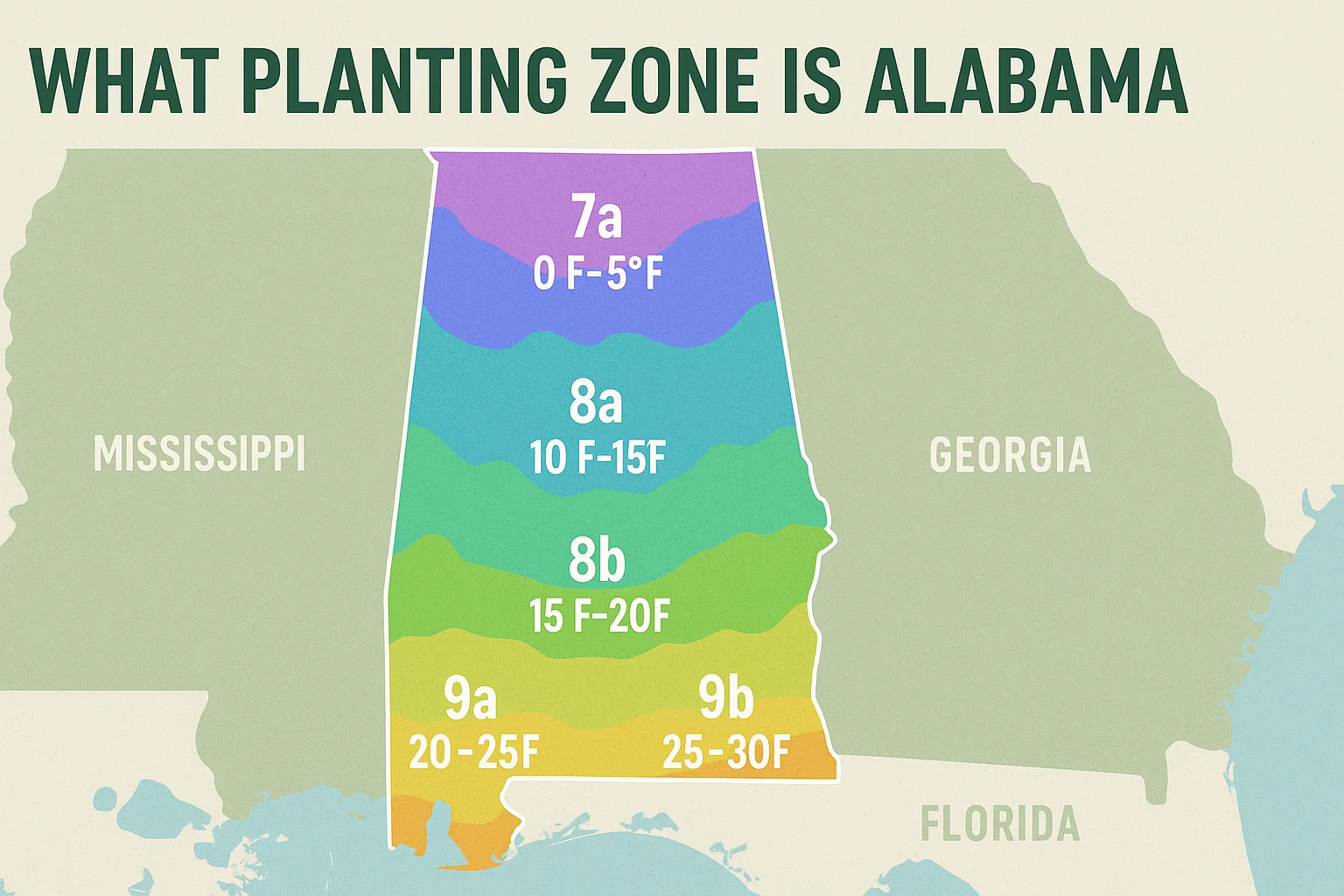What Planting Zone is Alabama?[Map, Cities, and Growing Tips]

When it comes to gardening or landscaping in Alabama, one of the first things you need to know is your USDA Plant Hardiness Zone — also known as a planting zone. This simple number (or letter-number combo) helps you choose plants that will actually survive and thrive where you live. But what planting zone is Alabama, exactly?
In this guide, we’ll break it down by region, explain how the zones affect your plant choices, and give you real-world tips on growing successfully in Alabama’s varied climate.
What Planting Zone is Alabama?
Alabama falls across USDA Zones 7a to 9a, depending on where you live:
| Region | USDA Zone |
|---|---|
| Northern Alabama (e.g., Huntsville) | Zone 7a |
| Central Alabama (e.g., Birmingham, Montgomery) | Zone 8a |
| Southern Alabama (e.g., Mobile, Gulf Shores) | Zone 9a |
These zones are based on the average minimum winter temperatures in your area — a crucial factor for perennial plants, trees, and shrubs. Zone 7a means your area can see temps as low as 0°F to 5°F in winter, while Zone 9a means you probably won’t see anything colder than 20°F.
📍 Alabama Planting Zones by City
To make it easier, here’s a quick look at the USDA planting zones for major Alabama cities:
| City | Planting Zone |
|---|---|
| Birmingham | Zone 8a |
| Montgomery | Zone 8a |
| Huntsville | Zone 7a |
| Tuscaloosa | Zone 8a |
| Mobile | Zone 9a |
| Dothan | Zone 8b |
| Auburn | Zone 8a |
| Florence | Zone 7a |
| Gulf Shores | Zone 9a |
If you’re somewhere between cities, chances are your planting zone lines up with the closest metro area — though microclimates can vary due to elevation, soil type, and even urban heat.
🌡️ Why Planting Zones Matter in Alabama?
You might be tempted to plant tropical hibiscus or cold-hardy lilacs anywhere in the state — but zone matters more than you think. If you’re in Huntsville, for example, and try growing something meant for Zone 9, it may not survive the winter. On the flip side, a cold-loving peony might not bloom well in Mobile’s mild winters.
Knowing your planting zone helps you:
- Pick perennials that survive year after year
- Plan your sowing schedule for vegetables
- Avoid frost damage to new growth
- Choose the right trees and shrubs for long-term success
🧠 Real-World Example: Tomatoes in Zone 7a vs. Zone 9a
In Zone 7a (Huntsville), tomato planting typically begins around late April, after the last frost. But in Zone 9a (Mobile), you could start in late February or early March — and might even be able to plant a second crop in late summer.
This matters for:
- Yield
- Pest pressure
- Soil temperature
- Overall growing season length
The warmer the zone, the longer your growing season, and the more flexibility you have.
📅 When to Plant in Alabama?
Here’s a rough planting calendar based on your zone:
| Crop Type | Zone 7a Start | Zone 8a Start | Zone 9a Start |
|---|---|---|---|
| Cool-weather (lettuce, kale) | Feb–Mar | Jan–Feb | Dec–Jan |
| Warm-weather (tomatoes, peppers) | Apr–May | Mar–Apr | Feb–Mar |
| Perennials | Fall or early spring | Fall or early spring | Fall (best) |
Remember, these are guidelines. Watch your local frost dates and soil temperatures for best results.
Tips for Gardening in Alabama’s Climate
Alabama offers a humid subtropical climate, which brings opportunities — and challenges:
✅ Do:
- Use mulch to retain soil moisture and reduce weeds
- Choose heat-tolerant, disease-resistant varieties
- Amend your soil — many Alabama soils are heavy clay or sandy
- Rotate crops to avoid nematodes and disease buildup
❌ Avoid:
- Planting too early (freak cold snaps still happen)
- Overwatering during rainy months (watch for root rot)
- Forgetting about pest pressure — aphids, hornworms, and beetles love the heat
Want to Check Your Zip Code?
Don’t rely just on your city — planting zones can shift slightly by zip code, especially in hilly or coastal regions.
You can check your specific planting zone by entering your zip code on the official USDA Plant Hardiness Zone Map. This will give you the most accurate zone for your exact location.
Recommended Tools for Alabama Gardeners
Want to take the guesswork out of planning your garden? These free tools can help:
- Soil Volume Calculator – Know exactly how much soil you need for raised beds.
- Plant Spacing Calculator – Prevent overcrowding and maximize yield.
- Indoor Plant Watering Calculator – Perfect for your houseplants or container garden.
🙋 Frequently Asked Questions
What is the best zone for gardening in Alabama?
Zone 8a covers much of central Alabama and offers a long, balanced growing season — perfect for a wide variety of vegetables and flowers.
Can I grow citrus in Alabama?
Yes! In Zone 9a (southern Alabama), citrus trees like satsumas and Meyer lemons can survive outdoors. In Zones 7–8, they’ll need protection or to be grown in containers.
When is the last frost in Alabama?
- Zone 7a: Around mid-April
- Zone 8a: Around late March
- Zone 9a: Early March or earlier
Final Thoughts: Gardening in Alabama’s Planting Zones
Understanding your Alabama planting zone is step one in becoming a successful gardener. Whether you’re in the frosty edge of Zone 7 or the balmy coast of Zone 9, your zone affects everything from what you plant to when you plant it.
So before you dig in the dirt, check your zone — and match your plants to the place they’ll call home.
🌿 Happy growing, Alabama!
